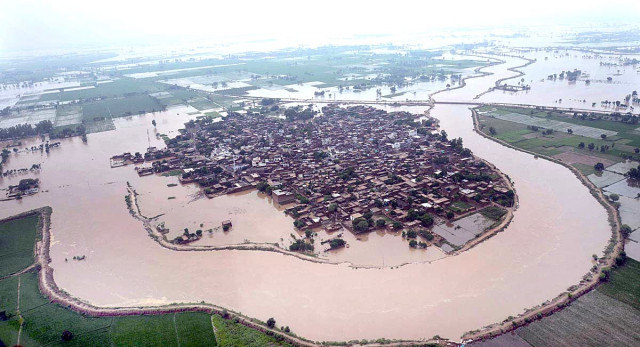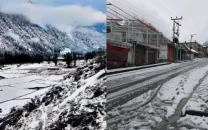Flooding in Punjab: Floods swamp nearly 200 villages in Chiniot, Sialkot
Red alert in South Punjab, mass evacuations under way, 150 more villages at risk.

An aerial view of the flood-hit area of Boddomali in Sialkot. PHOTO: APP
Nearly 200 villages in Chiniot and Sialkot districts were submerged as close to 600,000 cusecs of water flowed into the River Chenab during the last 24 hours. While the water level in central Punjab and the River Chenab starts to recede and collects in the River Indus, the low-lying areas of southern Punjab were put on red alert: the army has been called in.
Ninety villages were swamped in Sialkot. They were literally cut off from the city as the area was inundated due to a breach near the Bajwat bridge and the doubling of the water level in Aek Nala.
Prime Minister Nawaz Sharif had an aerial view of the submerged areas of Sialkot, Chiniot and Narowal districts on Saturday. Speaking at a briefing after his visit, he announced Rs500,000 in compensation for each of the affected families.
The government, meanwhile, issued flood warnings for another 150 villages adjacent to Chiniot. However, local administrator Dr Muhammad Irshad voiced hope that with the decreasing water level in the River Chenab, damage would be minimal. This is exactly what happened and by Saturday evening, it was recorded that the water level in the River Chenab began to recede and the flood threat moved south.
Heading south
With the water level rising to 500,000 cusecs in the River Indus in Rajanpur district, major areas of south Punjab have been handed over to Pakistan Army. Multan is most at risk as the River Chenab and its water bodies surround the city from three sides. Officials say that the next 24 to 48 hours would be crucial.
Already 16 villages are inundated in the Shujabad sub-district of Multan. DCO Gulzar Shah has asked for more troops in Shujabad and Jalalpur Pirwala. Inter-Services Public Relations (ISPR) officials told The Express Tribune that two companies of Pakistan Army have been deputed on the Shershah and Bosan dyke, which are at risk from the overflow in Chenab.
Northeast of Multan, in Sahiwal district, almost 13 rural settlements submerged as the banks of River Ravi brimmed over. More than 1,200 people have been evacuated and moved to relief camps set up by the government in the upper sides of the river.
In Layyah district, situated in the low-lying area east of the River Indus, the government has evacuated and sent around 10,000 people to safe places during the last 48 hours.

Chachra Sharif and the Head Panjnad Barrage are the two main areas being monitored under the flood watch. DESIGN: FAIZAN DAWOOD
On the west of the Indus, all rural areas of Rajanpur district have been vacated. The district is just north of Chachra Sharif, the collection point of all the four tributaries into River Indus. This area is at extremely high risk as the rising water level is accumulating here.
Another accumulation point under watch is the Head Panjad Barrage, near Alipur, where all public activity has been banned.
Meanwhile, in Rahim Yar Khan, the district government is convincing residents of 148 villages to evacuate before the 600,000-cusec flood swell of River Indus sweep away the settlements. South Punjab has the biggest irrigation network for more than two million acres of agricultural lands in almost 18 districts. Its population could be at risk.
Other areas taking precaution
Even though Bahawalpur and Bahawalnagar face no direct threat due to the current water flow in River Sutlej, Bahawalpur DCO Asadullah Khan said that the district government was taking precautionary measures nevertheless.
Health department teams have been stationed in these areas, while livestock department teams are vaccinating cattle, Khan told reporters.
What flood and why?
South Punjab is vulnerable because of the impending overflow of most of the province’s rivers, namely Ravi, Sutlej, Chenab and Indus. Perhaps the most devastating flood spells may come through River Indus, which could hit either on Sunday and Monday.
There are two causes of the flood in the region. The first reason is the rising level of water in rivers that inundates surrounding areas and swamps the temporary and permanent settlements in and around the dykes. The second cause of the flood is a breach in the bunds – usually old and damaged ones – that allows a torrent of water into the villages earlier protected. Villagers in the city flood-relief camp, sector two, at the Government Girls High School, Layyah, protested against the Punjab government for not repairing the Layyah bund in time, despite reminders.
No food, no information
Experts believe that another looming threat, along with this rising level of water, is a food crisis – agricultural lands have been devastated in the floods earlier this month. Cotton, rice and sugarcane crops will suffer the most and an estimated area of 150,000 acres of cropland has been affected so far.
When DCOs across Punjab were asked how many people have been affected and how many more would be vulnerable, they just shrugged their shoulders. Rahim Yar Khan DCO Nabeel Javed later explained that it is hard to figure out how many would be affected.
Sindh
Most of the katcha areas between Guddu and Sukkur barrages have also been submerged and residents of Kashmore, Ghotki, Sukkur and Khairpur have been moved to the safer places via boats.
But the damage is expected to be minimal as most of the bunds can withstand the pressure of the rising water level as they were repaired last month, Mohammad Rafiq Deedur, the Guddu Barrage Superintendent Engineer told The Express Tribune.
Published in The Express Tribune, August 18th, 2013.



















COMMENTS
Comments are moderated and generally will be posted if they are on-topic and not abusive.
For more information, please see our Comments FAQ